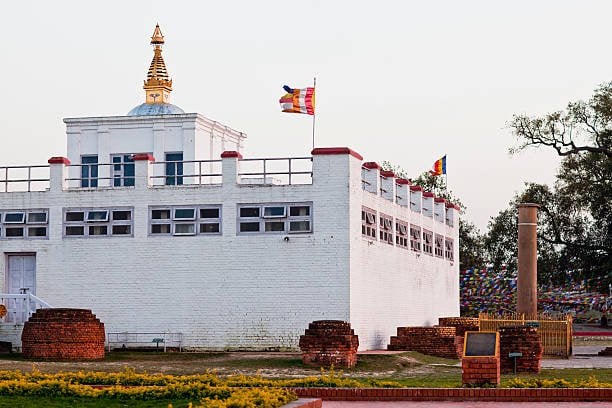The role of NRNA in promoting Lumbini as a spiritual and cultural hub

Imagine standing in a serene garden, the sunlight filtering through the leaves, as you approach a simple yet profound structure—the Maya Devi Temple. Here, in Lumbini, Nepal, lies the birthplace of Gautam Buddha, a figure whose teachings have touched the hearts of millions across the globe. Born Siddhartha Gautama in 563 BCE, Buddha’s journey from princely luxury to spiritual awakening invites us all to reflect on our own paths.
At the core of Buddhism are the Four Noble Truths and the Eightfold Path—simple yet profound teachings that explore the nature of suffering and the journey toward inner peace. The Four Noble Truths remind us that suffering exists, that it arises from our desires, that it can end, and that a clear path can lead us there. The Eightfold Path offers practical guidance, encompassing right understanding, thought, speech, action, livelihood, effort, mindfulness, and concentration. These principles resonate with people from all walks of life, offering a timeless guide to living a meaningful and compassionate existence.
Today, Buddhism has approximately 500 million followers worldwide, shaping spiritual and cultural landscapes far beyond its origins. Lumbini, once a humble pilgrimage site, has blossomed into a vibrant destination that attracts between 500,000 and 1 million visitors each year, eager to experience the spirit of this sacred place.
Lumbini is not just a historical site; it is a living symbol of hope and peace. Here, the teachings of the Buddha come alive in the beauty of the surrounding landscape and the warmth of the local community. The Maya Devi Temple marks the exact spot of Siddhartha’s birth, while the Ashoka Pillar, standing tall since the 3rd century BCE, tells the story of a rich heritage that has survived the test of time.
As you wander through the site, you will encounter monasteries and meditation centers that reflect the diversity of Buddhist traditions from around the world. The Japanese Peace Pagoda, the Royal Thai Monastery, the Korean Buddhist Temple, and the Sri Lankan Monastery each add unique flavors to Lumbini’s cultural tapestry, creating a rich experience for visitors.
Lumbini’s significance as a pilgrimage site has not only spiritual implications but also profound economic ones. As a key destination on the Buddhist tourism map, it brings vital economic opportunities to local communities. From hospitality to local crafts and tourism services, the benefits of this spiritual haven extend far beyond its borders. As Lumbini gains international attention, it is poised to play an even greater role in Nepal’s economic landscape.
One of the remarkable aspects of Lumbini is its ability to foster cultural exchange and understanding among diverse communities. Each monastery and temple tells a story of its own, representing different traditions and ways of life. Visitors from all corners of the globe come together in this sacred space, united by their shared respect for the teachings of the Buddha.

As Lumbini continues to grow as a tourist destination, the importance of sustainable practices cannot be overstated. Balancing the influx of visitors with the preservation of the environment and local culture is crucial. Implementing eco-friendly practices, like using renewable energy, conserving water, and managing waste effectively, can help ensure that Lumbini remains a pristine and welcoming place for generations to come.
Involving local communities in tourism activities is vital for sustainable development. When locals participate in guiding, crafting, and sharing their cultural heritage, they not only benefit economically but also help preserve their traditions. Encouraging eco-tourism and sustainable agriculture in the surrounding areas can further enhance the region’s resilience and support conservation efforts.
As we look toward the future, maintaining the sanctity of Lumbini remains paramount. Protecting its religious and historical significance is essential for ensuring that it continues to be a place of deep spiritual reflection. Striking a balance between development and preservation will require commitment from all stakeholders.
Here, the Non-Resident Nepali (NRN) community plays a crucial role. NRNs are ambassadors of Nepal, with the unique ability to promote and preserve Lumbini’s legacy on a global stage. Their advocacy can raise awareness and attract visitors, highlighting the significance of Lumbini as a key Buddhist tourism destination.
By organizing international events, conferences, and exhibitions, NRNs can create excitement and interest around Lumbini. Their voices can amplify its importance through social media, publications, and outreach, helping more people discover this sacred site.
Supporting local businesses and initiatives is another way NRNs can contribute to Lumbini’s growth. By investing in tourism infrastructure and services, they can help enhance the visitor experience while ensuring that the economic benefits flow back into the community.
Educational programs and outreach initiatives supported by NRNs can deepen the understanding of Lumbini’s historical and spiritual importance. Research, publications, and educational initiatives can enlighten both the global public and the Nepali diaspora about what Lumbini represents.
Sustainable development advocacy is essential for NRNs. By promoting eco-friendly tourism practices and pushing for the preservation of Lumbini’s sacred heritage, they can help ensure that growth does not come at the expense of what makes Lumbini special.
Collaborating with international Buddhist communities can further elevate Lumbini’s profile. Joint events, such as Buddhist festivals and conferences, can attract global attention, drawing practitioners and enthusiasts from around the world to celebrate and learn about this sacred site.
Engaging with Buddhist leaders and organizations allows for the exchange of ideas and best practices, leading to initiatives that enhance Lumbini’s global significance. These collaborations can result in impactful projects that not only promote Lumbini but also help protect its rich cultural and spiritual heritage.
In conclusion, Lumbini, as the birthplace of Gautam Buddha, is a beacon of hope and peace for millions around the world. With its deep spiritual significance and annual visitor numbers ranging from 500,000 to 1 million, it stands as a vital pilgrimage site. As Lumbini continues to develop as a key tourism destination, balancing growth with preservation is essential. With the support of the NRN community, the Nepali diaspora, and global Buddhist communities, Lumbini can remain a meaningful center for spiritual reflection and cultural exchange, benefiting generations to come and preserving its sacred legacy for years ahead.
(The author serves as the international coordinator of Lumbini Sanskritik Municipality in Rupandehi.)


Leave Comment